MGMT6000 - Leadership: A Personal and Professional Development Plan
VerifiedAdded on 2023/06/14
|13
|3182
|379
Report
AI Summary
This assignment presents a personal and professional development plan focused on enhancing leadership capabilities. It identifies critical gaps between current skills and leadership aspirations, incorporating feedback and self-reflection. The plan outlines strategies for improving leadership and management skills, decision-making efficiency, communication, and technical knowledge. It addresses the influence of national and organizational cultures on leadership perspectives. The plan emphasizes self-awareness, ethical values, and the importance of balancing intrinsic and extrinsic motivations. It also highlights the need for continuous learning, adaptability, and building supportive teams to achieve sustainable results. Desklib offers a variety of similar documents to help students in their academic pursuits.
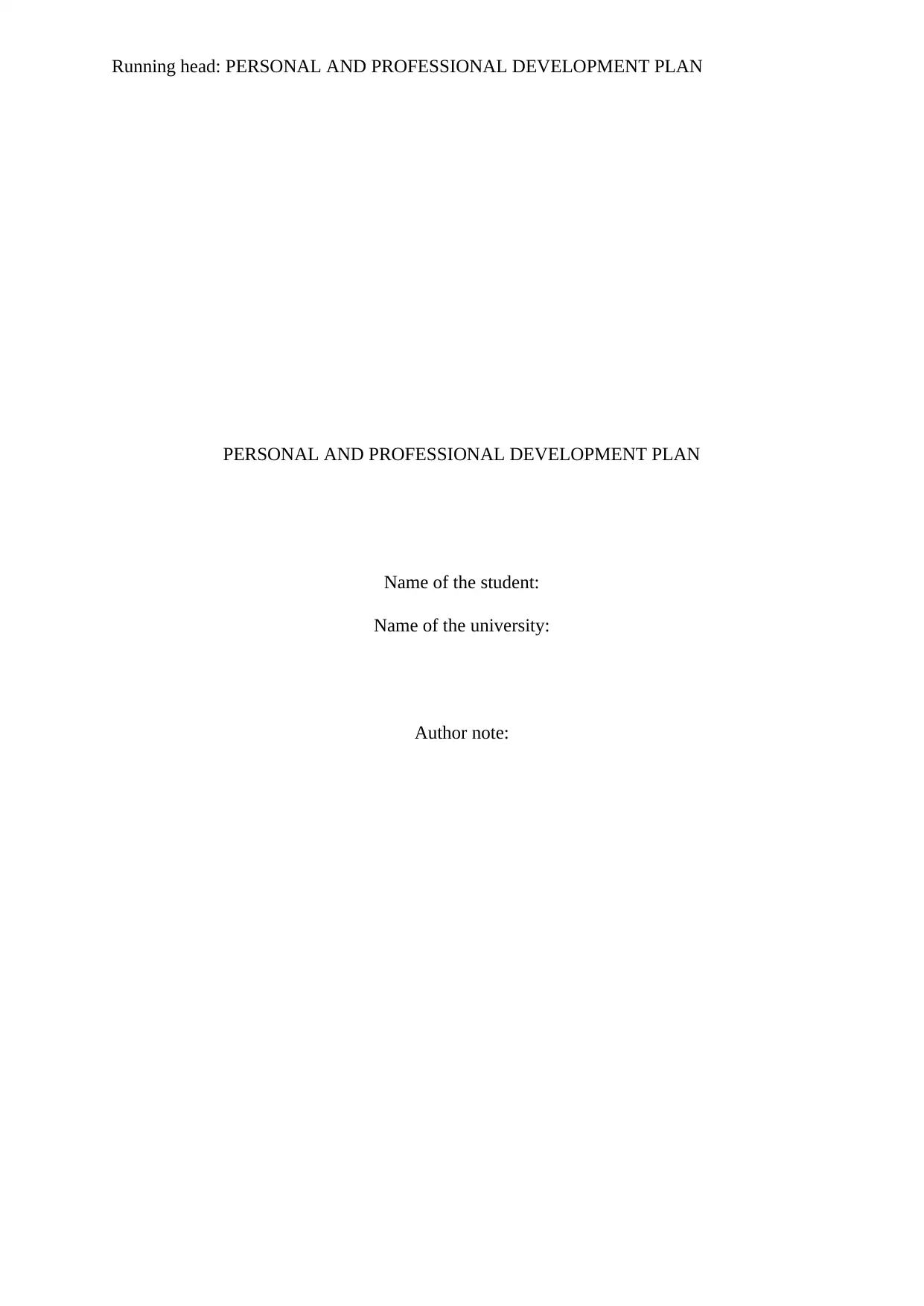
Running head: PERSONAL AND PROFESSIONAL DEVELOPMENT PLAN
PERSONAL AND PROFESSIONAL DEVELOPMENT PLAN
Name of the student:
Name of the university:
Author note:
PERSONAL AND PROFESSIONAL DEVELOPMENT PLAN
Name of the student:
Name of the university:
Author note:
Paraphrase This Document
Need a fresh take? Get an instant paraphrase of this document with our AI Paraphraser
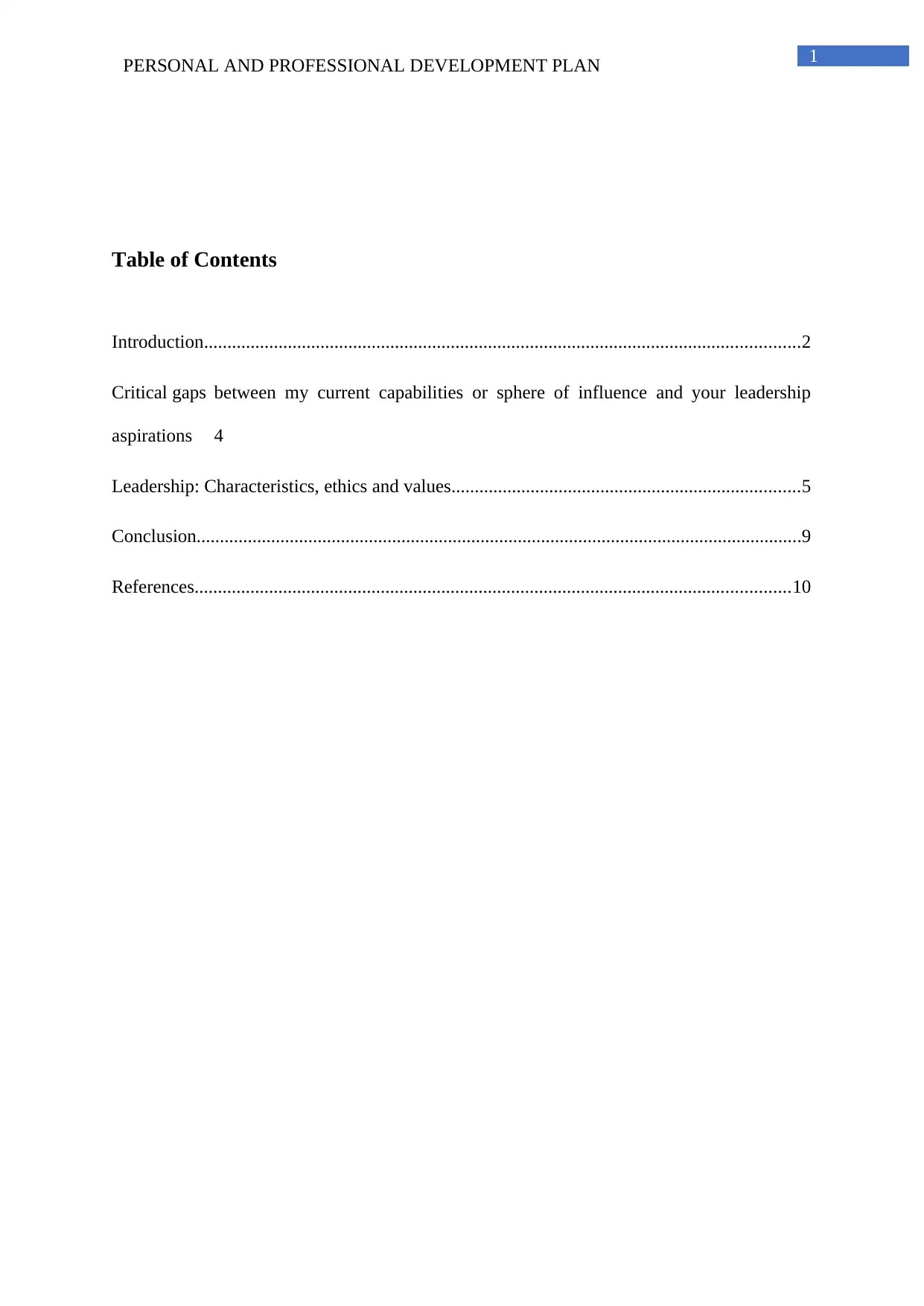
1
PERSONAL AND PROFESSIONAL DEVELOPMENT PLAN
Table of Contents
Introduction................................................................................................................................2
Critical gaps between my current capabilities or sphere of influence and your leadership
aspirations 4
Leadership: Characteristics, ethics and values...........................................................................5
Conclusion..................................................................................................................................9
References................................................................................................................................10
PERSONAL AND PROFESSIONAL DEVELOPMENT PLAN
Table of Contents
Introduction................................................................................................................................2
Critical gaps between my current capabilities or sphere of influence and your leadership
aspirations 4
Leadership: Characteristics, ethics and values...........................................................................5
Conclusion..................................................................................................................................9
References................................................................................................................................10
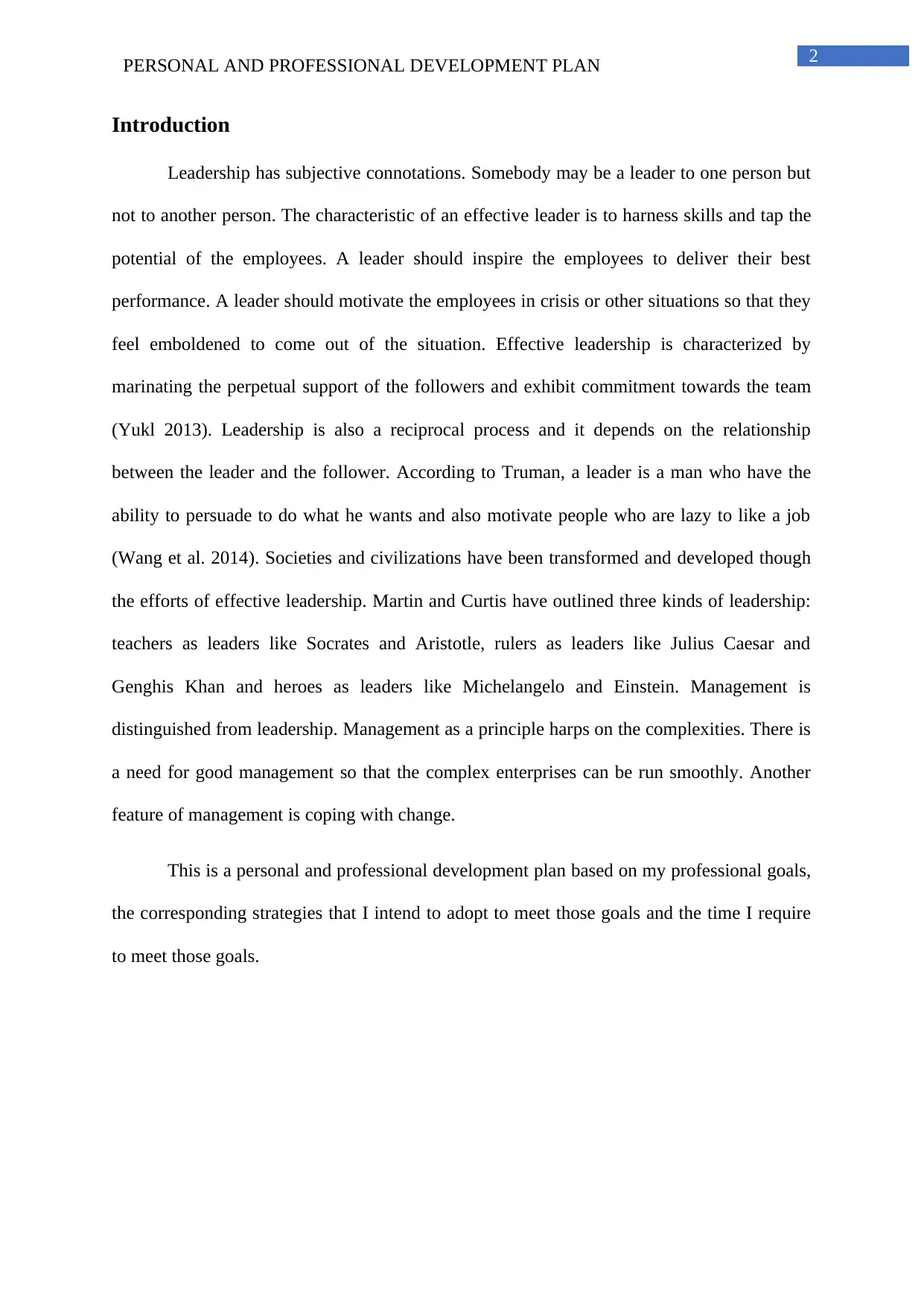
2
PERSONAL AND PROFESSIONAL DEVELOPMENT PLAN
Introduction
Leadership has subjective connotations. Somebody may be a leader to one person but
not to another person. The characteristic of an effective leader is to harness skills and tap the
potential of the employees. A leader should inspire the employees to deliver their best
performance. A leader should motivate the employees in crisis or other situations so that they
feel emboldened to come out of the situation. Effective leadership is characterized by
marinating the perpetual support of the followers and exhibit commitment towards the team
(Yukl 2013). Leadership is also a reciprocal process and it depends on the relationship
between the leader and the follower. According to Truman, a leader is a man who have the
ability to persuade to do what he wants and also motivate people who are lazy to like a job
(Wang et al. 2014). Societies and civilizations have been transformed and developed though
the efforts of effective leadership. Martin and Curtis have outlined three kinds of leadership:
teachers as leaders like Socrates and Aristotle, rulers as leaders like Julius Caesar and
Genghis Khan and heroes as leaders like Michelangelo and Einstein. Management is
distinguished from leadership. Management as a principle harps on the complexities. There is
a need for good management so that the complex enterprises can be run smoothly. Another
feature of management is coping with change.
This is a personal and professional development plan based on my professional goals,
the corresponding strategies that I intend to adopt to meet those goals and the time I require
to meet those goals.
PERSONAL AND PROFESSIONAL DEVELOPMENT PLAN
Introduction
Leadership has subjective connotations. Somebody may be a leader to one person but
not to another person. The characteristic of an effective leader is to harness skills and tap the
potential of the employees. A leader should inspire the employees to deliver their best
performance. A leader should motivate the employees in crisis or other situations so that they
feel emboldened to come out of the situation. Effective leadership is characterized by
marinating the perpetual support of the followers and exhibit commitment towards the team
(Yukl 2013). Leadership is also a reciprocal process and it depends on the relationship
between the leader and the follower. According to Truman, a leader is a man who have the
ability to persuade to do what he wants and also motivate people who are lazy to like a job
(Wang et al. 2014). Societies and civilizations have been transformed and developed though
the efforts of effective leadership. Martin and Curtis have outlined three kinds of leadership:
teachers as leaders like Socrates and Aristotle, rulers as leaders like Julius Caesar and
Genghis Khan and heroes as leaders like Michelangelo and Einstein. Management is
distinguished from leadership. Management as a principle harps on the complexities. There is
a need for good management so that the complex enterprises can be run smoothly. Another
feature of management is coping with change.
This is a personal and professional development plan based on my professional goals,
the corresponding strategies that I intend to adopt to meet those goals and the time I require
to meet those goals.
⊘ This is a preview!⊘
Do you want full access?
Subscribe today to unlock all pages.

Trusted by 1+ million students worldwide
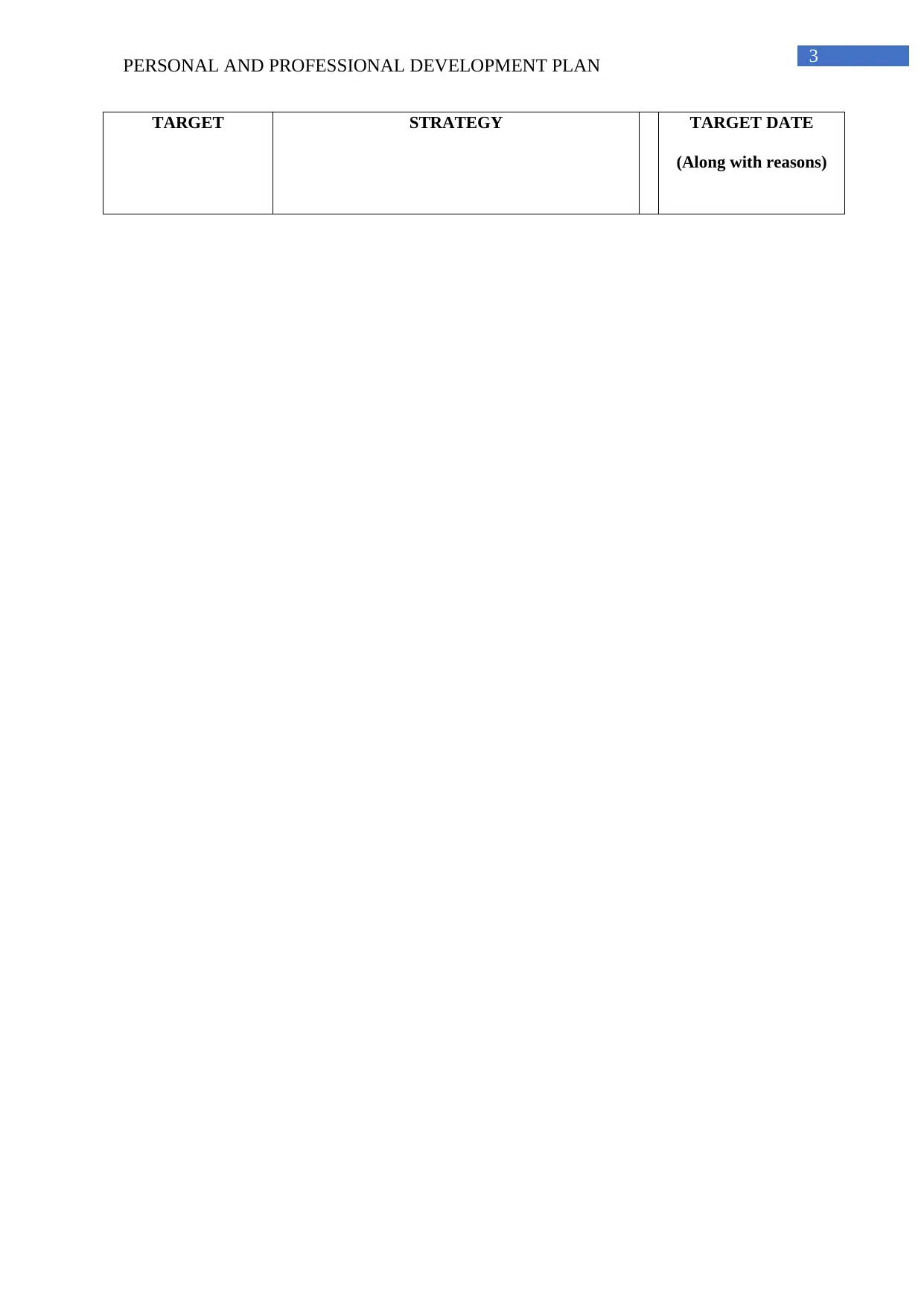
3
PERSONAL AND PROFESSIONAL DEVELOPMENT PLAN
TARGET STRATEGY TARGET DATE
(Along with reasons)
PERSONAL AND PROFESSIONAL DEVELOPMENT PLAN
TARGET STRATEGY TARGET DATE
(Along with reasons)
Paraphrase This Document
Need a fresh take? Get an instant paraphrase of this document with our AI Paraphraser
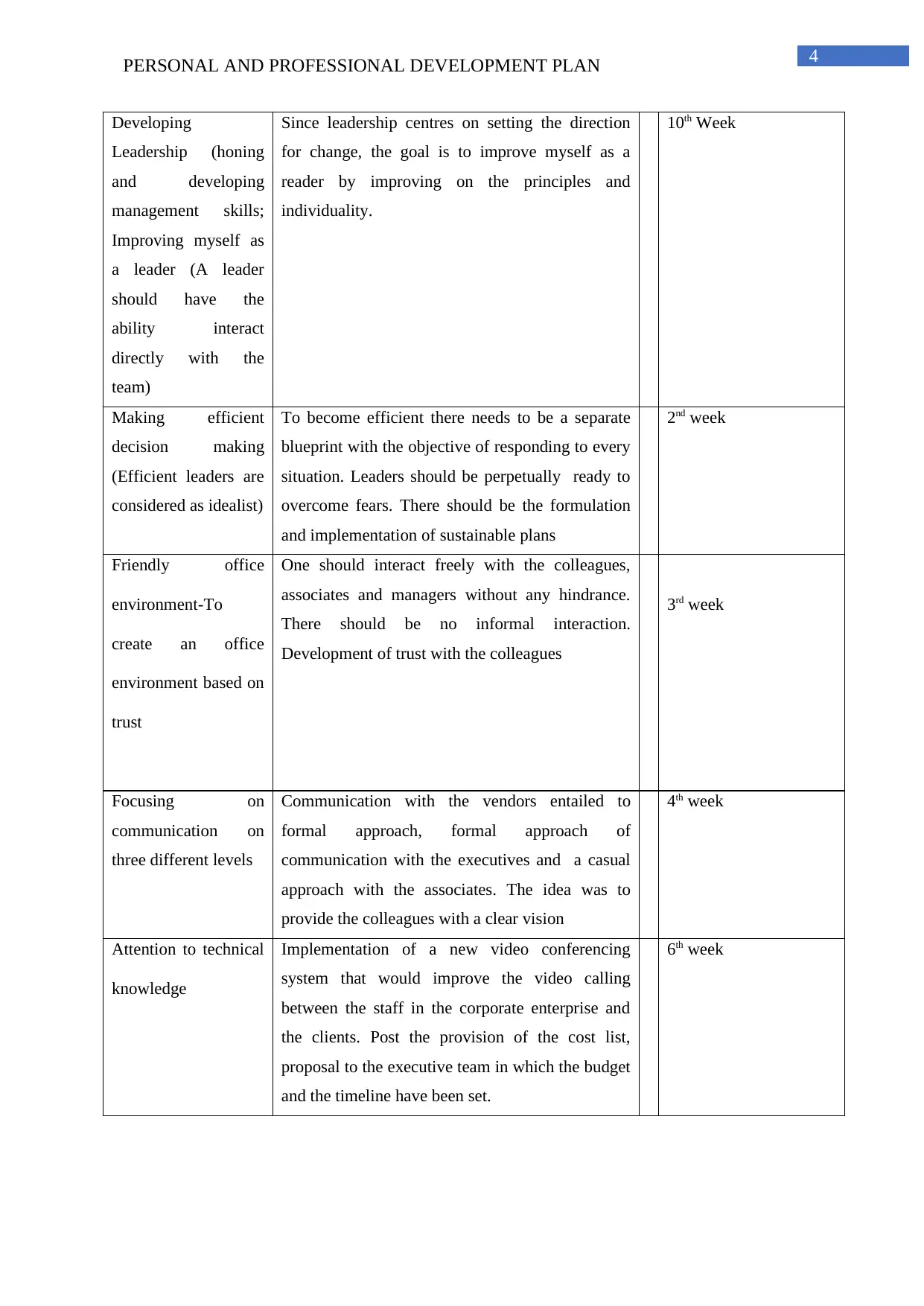
4
PERSONAL AND PROFESSIONAL DEVELOPMENT PLAN
Developing
Leadership (honing
and developing
management skills;
Improving myself as
a leader (A leader
should have the
ability interact
directly with the
team)
Since leadership centres on setting the direction
for change, the goal is to improve myself as a
reader by improving on the principles and
individuality.
10th Week
Making efficient
decision making
(Efficient leaders are
considered as idealist)
To become efficient there needs to be a separate
blueprint with the objective of responding to every
situation. Leaders should be perpetually ready to
overcome fears. There should be the formulation
and implementation of sustainable plans
2nd week
Friendly office
environment-To
create an office
environment based on
trust
One should interact freely with the colleagues,
associates and managers without any hindrance.
There should be no informal interaction.
Development of trust with the colleagues
3rd week
Focusing on
communication on
three different levels
Communication with the vendors entailed to
formal approach, formal approach of
communication with the executives and a casual
approach with the associates. The idea was to
provide the colleagues with a clear vision
4th week
Attention to technical
knowledge
Implementation of a new video conferencing
system that would improve the video calling
between the staff in the corporate enterprise and
the clients. Post the provision of the cost list,
proposal to the executive team in which the budget
and the timeline have been set.
6th week
PERSONAL AND PROFESSIONAL DEVELOPMENT PLAN
Developing
Leadership (honing
and developing
management skills;
Improving myself as
a leader (A leader
should have the
ability interact
directly with the
team)
Since leadership centres on setting the direction
for change, the goal is to improve myself as a
reader by improving on the principles and
individuality.
10th Week
Making efficient
decision making
(Efficient leaders are
considered as idealist)
To become efficient there needs to be a separate
blueprint with the objective of responding to every
situation. Leaders should be perpetually ready to
overcome fears. There should be the formulation
and implementation of sustainable plans
2nd week
Friendly office
environment-To
create an office
environment based on
trust
One should interact freely with the colleagues,
associates and managers without any hindrance.
There should be no informal interaction.
Development of trust with the colleagues
3rd week
Focusing on
communication on
three different levels
Communication with the vendors entailed to
formal approach, formal approach of
communication with the executives and a casual
approach with the associates. The idea was to
provide the colleagues with a clear vision
4th week
Attention to technical
knowledge
Implementation of a new video conferencing
system that would improve the video calling
between the staff in the corporate enterprise and
the clients. Post the provision of the cost list,
proposal to the executive team in which the budget
and the timeline have been set.
6th week
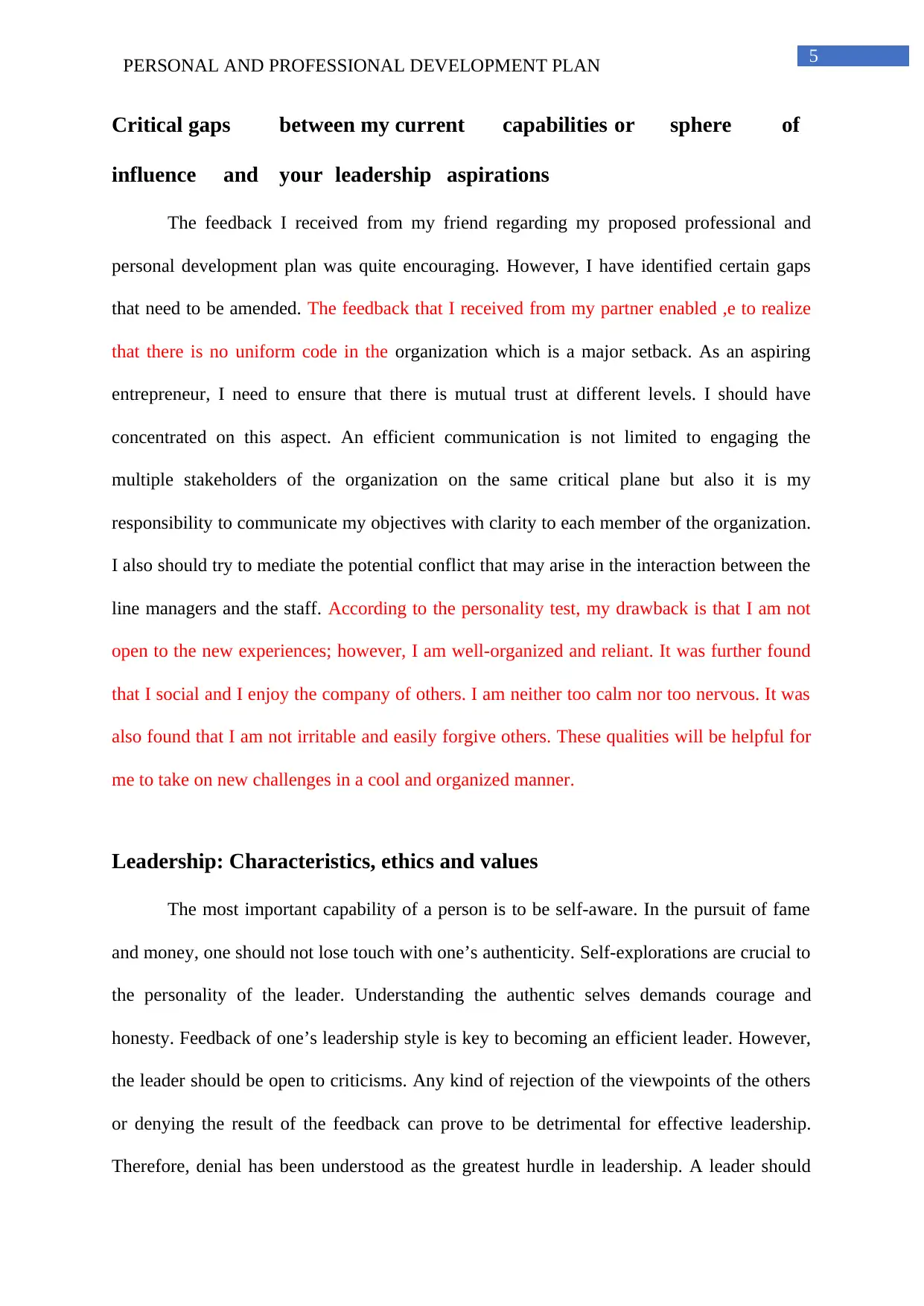
5
PERSONAL AND PROFESSIONAL DEVELOPMENT PLAN
Critical gaps between my current capabilities or sphere of
influence and your leadership aspirations
The feedback I received from my friend regarding my proposed professional and
personal development plan was quite encouraging. However, I have identified certain gaps
that need to be amended. The feedback that I received from my partner enabled ,e to realize
that there is no uniform code in the organization which is a major setback. As an aspiring
entrepreneur, I need to ensure that there is mutual trust at different levels. I should have
concentrated on this aspect. An efficient communication is not limited to engaging the
multiple stakeholders of the organization on the same critical plane but also it is my
responsibility to communicate my objectives with clarity to each member of the organization.
I also should try to mediate the potential conflict that may arise in the interaction between the
line managers and the staff. According to the personality test, my drawback is that I am not
open to the new experiences; however, I am well-organized and reliant. It was further found
that I social and I enjoy the company of others. I am neither too calm nor too nervous. It was
also found that I am not irritable and easily forgive others. These qualities will be helpful for
me to take on new challenges in a cool and organized manner.
Leadership: Characteristics, ethics and values
The most important capability of a person is to be self-aware. In the pursuit of fame
and money, one should not lose touch with one’s authenticity. Self-explorations are crucial to
the personality of the leader. Understanding the authentic selves demands courage and
honesty. Feedback of one’s leadership style is key to becoming an efficient leader. However,
the leader should be open to criticisms. Any kind of rejection of the viewpoints of the others
or denying the result of the feedback can prove to be detrimental for effective leadership.
Therefore, denial has been understood as the greatest hurdle in leadership. A leader should
PERSONAL AND PROFESSIONAL DEVELOPMENT PLAN
Critical gaps between my current capabilities or sphere of
influence and your leadership aspirations
The feedback I received from my friend regarding my proposed professional and
personal development plan was quite encouraging. However, I have identified certain gaps
that need to be amended. The feedback that I received from my partner enabled ,e to realize
that there is no uniform code in the organization which is a major setback. As an aspiring
entrepreneur, I need to ensure that there is mutual trust at different levels. I should have
concentrated on this aspect. An efficient communication is not limited to engaging the
multiple stakeholders of the organization on the same critical plane but also it is my
responsibility to communicate my objectives with clarity to each member of the organization.
I also should try to mediate the potential conflict that may arise in the interaction between the
line managers and the staff. According to the personality test, my drawback is that I am not
open to the new experiences; however, I am well-organized and reliant. It was further found
that I social and I enjoy the company of others. I am neither too calm nor too nervous. It was
also found that I am not irritable and easily forgive others. These qualities will be helpful for
me to take on new challenges in a cool and organized manner.
Leadership: Characteristics, ethics and values
The most important capability of a person is to be self-aware. In the pursuit of fame
and money, one should not lose touch with one’s authenticity. Self-explorations are crucial to
the personality of the leader. Understanding the authentic selves demands courage and
honesty. Feedback of one’s leadership style is key to becoming an efficient leader. However,
the leader should be open to criticisms. Any kind of rejection of the viewpoints of the others
or denying the result of the feedback can prove to be detrimental for effective leadership.
Therefore, denial has been understood as the greatest hurdle in leadership. A leader should
⊘ This is a preview!⊘
Do you want full access?
Subscribe today to unlock all pages.

Trusted by 1+ million students worldwide
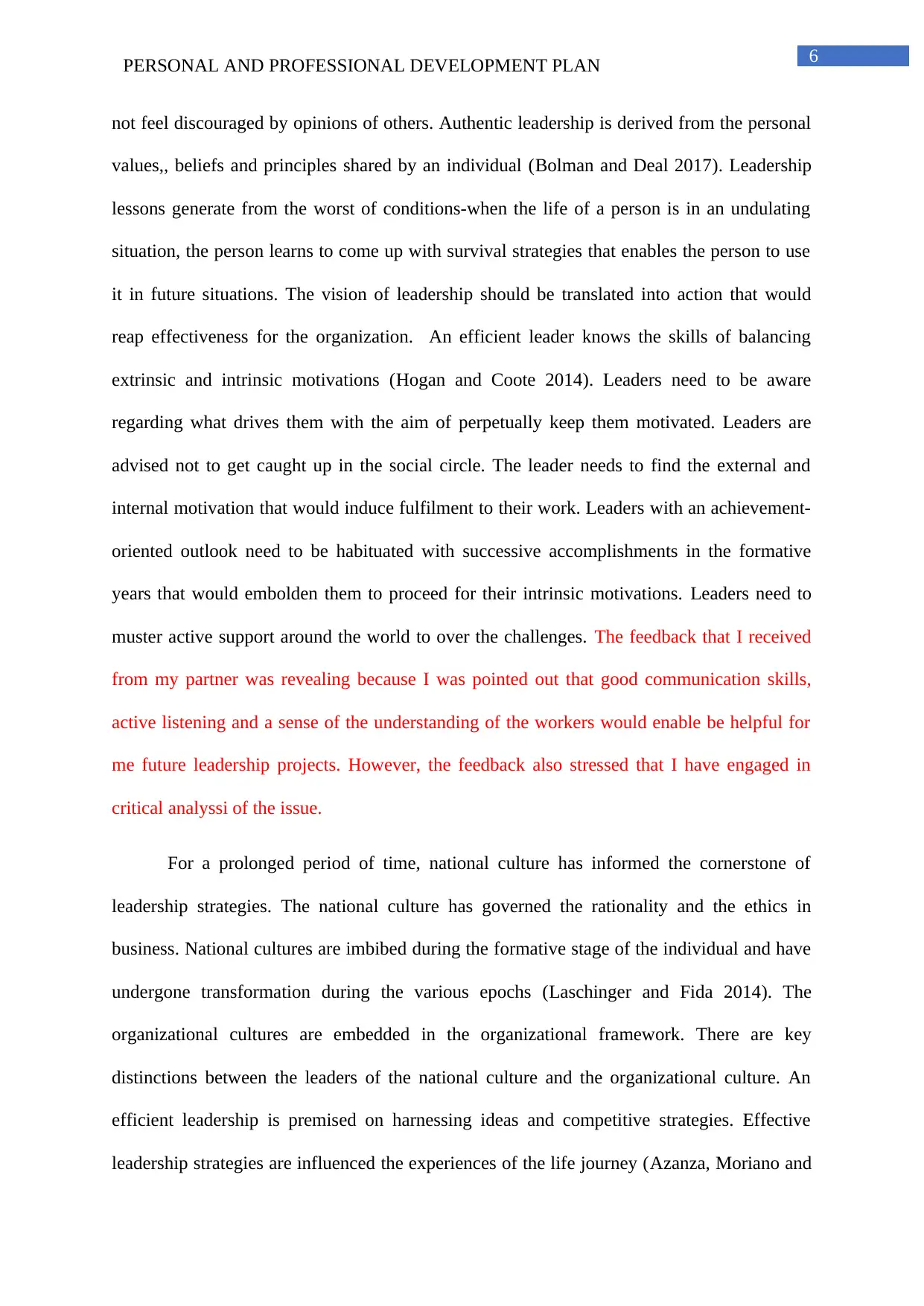
6
PERSONAL AND PROFESSIONAL DEVELOPMENT PLAN
not feel discouraged by opinions of others. Authentic leadership is derived from the personal
values,, beliefs and principles shared by an individual (Bolman and Deal 2017). Leadership
lessons generate from the worst of conditions-when the life of a person is in an undulating
situation, the person learns to come up with survival strategies that enables the person to use
it in future situations. The vision of leadership should be translated into action that would
reap effectiveness for the organization. An efficient leader knows the skills of balancing
extrinsic and intrinsic motivations (Hogan and Coote 2014). Leaders need to be aware
regarding what drives them with the aim of perpetually keep them motivated. Leaders are
advised not to get caught up in the social circle. The leader needs to find the external and
internal motivation that would induce fulfilment to their work. Leaders with an achievement-
oriented outlook need to be habituated with successive accomplishments in the formative
years that would embolden them to proceed for their intrinsic motivations. Leaders need to
muster active support around the world to over the challenges. The feedback that I received
from my partner was revealing because I was pointed out that good communication skills,
active listening and a sense of the understanding of the workers would enable be helpful for
me future leadership projects. However, the feedback also stressed that I have engaged in
critical analyssi of the issue.
For a prolonged period of time, national culture has informed the cornerstone of
leadership strategies. The national culture has governed the rationality and the ethics in
business. National cultures are imbibed during the formative stage of the individual and have
undergone transformation during the various epochs (Laschinger and Fida 2014). The
organizational cultures are embedded in the organizational framework. There are key
distinctions between the leaders of the national culture and the organizational culture. An
efficient leadership is premised on harnessing ideas and competitive strategies. Effective
leadership strategies are influenced the experiences of the life journey (Azanza, Moriano and
PERSONAL AND PROFESSIONAL DEVELOPMENT PLAN
not feel discouraged by opinions of others. Authentic leadership is derived from the personal
values,, beliefs and principles shared by an individual (Bolman and Deal 2017). Leadership
lessons generate from the worst of conditions-when the life of a person is in an undulating
situation, the person learns to come up with survival strategies that enables the person to use
it in future situations. The vision of leadership should be translated into action that would
reap effectiveness for the organization. An efficient leader knows the skills of balancing
extrinsic and intrinsic motivations (Hogan and Coote 2014). Leaders need to be aware
regarding what drives them with the aim of perpetually keep them motivated. Leaders are
advised not to get caught up in the social circle. The leader needs to find the external and
internal motivation that would induce fulfilment to their work. Leaders with an achievement-
oriented outlook need to be habituated with successive accomplishments in the formative
years that would embolden them to proceed for their intrinsic motivations. Leaders need to
muster active support around the world to over the challenges. The feedback that I received
from my partner was revealing because I was pointed out that good communication skills,
active listening and a sense of the understanding of the workers would enable be helpful for
me future leadership projects. However, the feedback also stressed that I have engaged in
critical analyssi of the issue.
For a prolonged period of time, national culture has informed the cornerstone of
leadership strategies. The national culture has governed the rationality and the ethics in
business. National cultures are imbibed during the formative stage of the individual and have
undergone transformation during the various epochs (Laschinger and Fida 2014). The
organizational cultures are embedded in the organizational framework. There are key
distinctions between the leaders of the national culture and the organizational culture. An
efficient leadership is premised on harnessing ideas and competitive strategies. Effective
leadership strategies are influenced the experiences of the life journey (Azanza, Moriano and
Paraphrase This Document
Need a fresh take? Get an instant paraphrase of this document with our AI Paraphraser
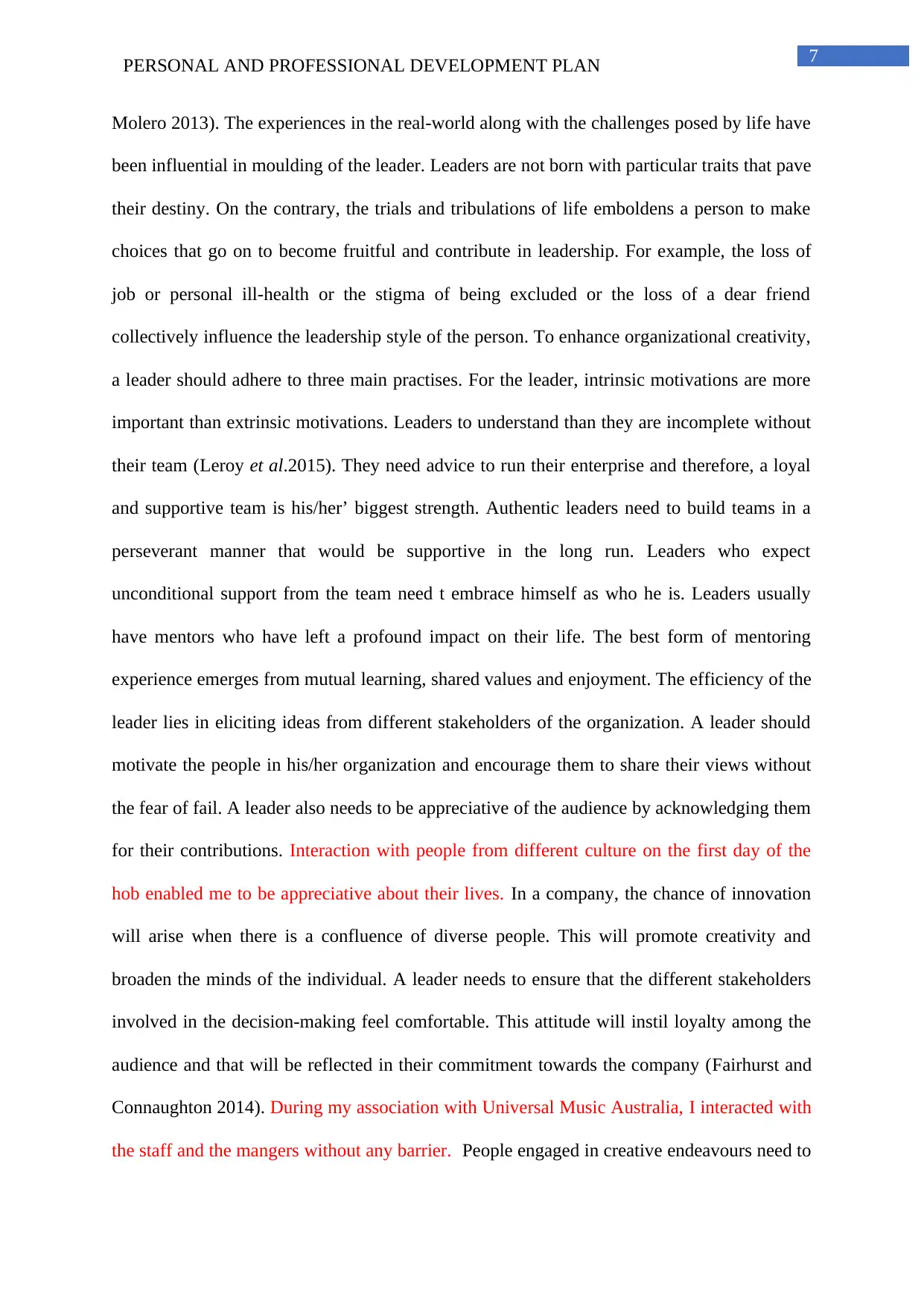
7
PERSONAL AND PROFESSIONAL DEVELOPMENT PLAN
Molero 2013). The experiences in the real-world along with the challenges posed by life have
been influential in moulding of the leader. Leaders are not born with particular traits that pave
their destiny. On the contrary, the trials and tribulations of life emboldens a person to make
choices that go on to become fruitful and contribute in leadership. For example, the loss of
job or personal ill-health or the stigma of being excluded or the loss of a dear friend
collectively influence the leadership style of the person. To enhance organizational creativity,
a leader should adhere to three main practises. For the leader, intrinsic motivations are more
important than extrinsic motivations. Leaders to understand than they are incomplete without
their team (Leroy et al.2015). They need advice to run their enterprise and therefore, a loyal
and supportive team is his/her’ biggest strength. Authentic leaders need to build teams in a
perseverant manner that would be supportive in the long run. Leaders who expect
unconditional support from the team need t embrace himself as who he is. Leaders usually
have mentors who have left a profound impact on their life. The best form of mentoring
experience emerges from mutual learning, shared values and enjoyment. The efficiency of the
leader lies in eliciting ideas from different stakeholders of the organization. A leader should
motivate the people in his/her organization and encourage them to share their views without
the fear of fail. A leader also needs to be appreciative of the audience by acknowledging them
for their contributions. Interaction with people from different culture on the first day of the
hob enabled me to be appreciative about their lives. In a company, the chance of innovation
will arise when there is a confluence of diverse people. This will promote creativity and
broaden the minds of the individual. A leader needs to ensure that the different stakeholders
involved in the decision-making feel comfortable. This attitude will instil loyalty among the
audience and that will be reflected in their commitment towards the company (Fairhurst and
Connaughton 2014). During my association with Universal Music Australia, I interacted with
the staff and the mangers without any barrier. People engaged in creative endeavours need to
PERSONAL AND PROFESSIONAL DEVELOPMENT PLAN
Molero 2013). The experiences in the real-world along with the challenges posed by life have
been influential in moulding of the leader. Leaders are not born with particular traits that pave
their destiny. On the contrary, the trials and tribulations of life emboldens a person to make
choices that go on to become fruitful and contribute in leadership. For example, the loss of
job or personal ill-health or the stigma of being excluded or the loss of a dear friend
collectively influence the leadership style of the person. To enhance organizational creativity,
a leader should adhere to three main practises. For the leader, intrinsic motivations are more
important than extrinsic motivations. Leaders to understand than they are incomplete without
their team (Leroy et al.2015). They need advice to run their enterprise and therefore, a loyal
and supportive team is his/her’ biggest strength. Authentic leaders need to build teams in a
perseverant manner that would be supportive in the long run. Leaders who expect
unconditional support from the team need t embrace himself as who he is. Leaders usually
have mentors who have left a profound impact on their life. The best form of mentoring
experience emerges from mutual learning, shared values and enjoyment. The efficiency of the
leader lies in eliciting ideas from different stakeholders of the organization. A leader should
motivate the people in his/her organization and encourage them to share their views without
the fear of fail. A leader also needs to be appreciative of the audience by acknowledging them
for their contributions. Interaction with people from different culture on the first day of the
hob enabled me to be appreciative about their lives. In a company, the chance of innovation
will arise when there is a confluence of diverse people. This will promote creativity and
broaden the minds of the individual. A leader needs to ensure that the different stakeholders
involved in the decision-making feel comfortable. This attitude will instil loyalty among the
audience and that will be reflected in their commitment towards the company (Fairhurst and
Connaughton 2014). During my association with Universal Music Australia, I interacted with
the staff and the mangers without any barrier. People engaged in creative endeavours need to
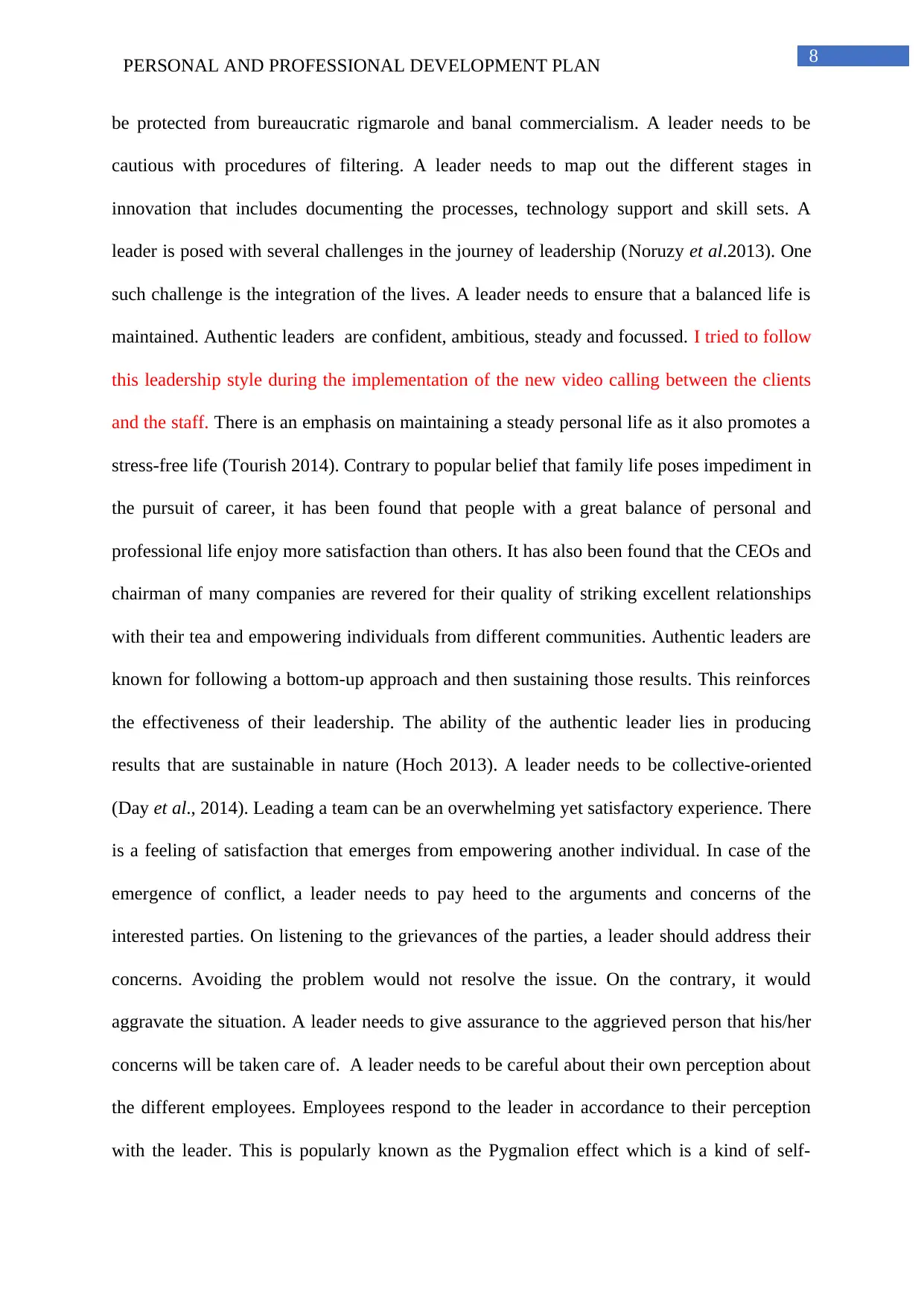
8
PERSONAL AND PROFESSIONAL DEVELOPMENT PLAN
be protected from bureaucratic rigmarole and banal commercialism. A leader needs to be
cautious with procedures of filtering. A leader needs to map out the different stages in
innovation that includes documenting the processes, technology support and skill sets. A
leader is posed with several challenges in the journey of leadership (Noruzy et al.2013). One
such challenge is the integration of the lives. A leader needs to ensure that a balanced life is
maintained. Authentic leaders are confident, ambitious, steady and focussed. I tried to follow
this leadership style during the implementation of the new video calling between the clients
and the staff. There is an emphasis on maintaining a steady personal life as it also promotes a
stress-free life (Tourish 2014). Contrary to popular belief that family life poses impediment in
the pursuit of career, it has been found that people with a great balance of personal and
professional life enjoy more satisfaction than others. It has also been found that the CEOs and
chairman of many companies are revered for their quality of striking excellent relationships
with their tea and empowering individuals from different communities. Authentic leaders are
known for following a bottom-up approach and then sustaining those results. This reinforces
the effectiveness of their leadership. The ability of the authentic leader lies in producing
results that are sustainable in nature (Hoch 2013). A leader needs to be collective-oriented
(Day et al., 2014). Leading a team can be an overwhelming yet satisfactory experience. There
is a feeling of satisfaction that emerges from empowering another individual. In case of the
emergence of conflict, a leader needs to pay heed to the arguments and concerns of the
interested parties. On listening to the grievances of the parties, a leader should address their
concerns. Avoiding the problem would not resolve the issue. On the contrary, it would
aggravate the situation. A leader needs to give assurance to the aggrieved person that his/her
concerns will be taken care of. A leader needs to be careful about their own perception about
the different employees. Employees respond to the leader in accordance to their perception
with the leader. This is popularly known as the Pygmalion effect which is a kind of self-
PERSONAL AND PROFESSIONAL DEVELOPMENT PLAN
be protected from bureaucratic rigmarole and banal commercialism. A leader needs to be
cautious with procedures of filtering. A leader needs to map out the different stages in
innovation that includes documenting the processes, technology support and skill sets. A
leader is posed with several challenges in the journey of leadership (Noruzy et al.2013). One
such challenge is the integration of the lives. A leader needs to ensure that a balanced life is
maintained. Authentic leaders are confident, ambitious, steady and focussed. I tried to follow
this leadership style during the implementation of the new video calling between the clients
and the staff. There is an emphasis on maintaining a steady personal life as it also promotes a
stress-free life (Tourish 2014). Contrary to popular belief that family life poses impediment in
the pursuit of career, it has been found that people with a great balance of personal and
professional life enjoy more satisfaction than others. It has also been found that the CEOs and
chairman of many companies are revered for their quality of striking excellent relationships
with their tea and empowering individuals from different communities. Authentic leaders are
known for following a bottom-up approach and then sustaining those results. This reinforces
the effectiveness of their leadership. The ability of the authentic leader lies in producing
results that are sustainable in nature (Hoch 2013). A leader needs to be collective-oriented
(Day et al., 2014). Leading a team can be an overwhelming yet satisfactory experience. There
is a feeling of satisfaction that emerges from empowering another individual. In case of the
emergence of conflict, a leader needs to pay heed to the arguments and concerns of the
interested parties. On listening to the grievances of the parties, a leader should address their
concerns. Avoiding the problem would not resolve the issue. On the contrary, it would
aggravate the situation. A leader needs to give assurance to the aggrieved person that his/her
concerns will be taken care of. A leader needs to be careful about their own perception about
the different employees. Employees respond to the leader in accordance to their perception
with the leader. This is popularly known as the Pygmalion effect which is a kind of self-
⊘ This is a preview!⊘
Do you want full access?
Subscribe today to unlock all pages.

Trusted by 1+ million students worldwide
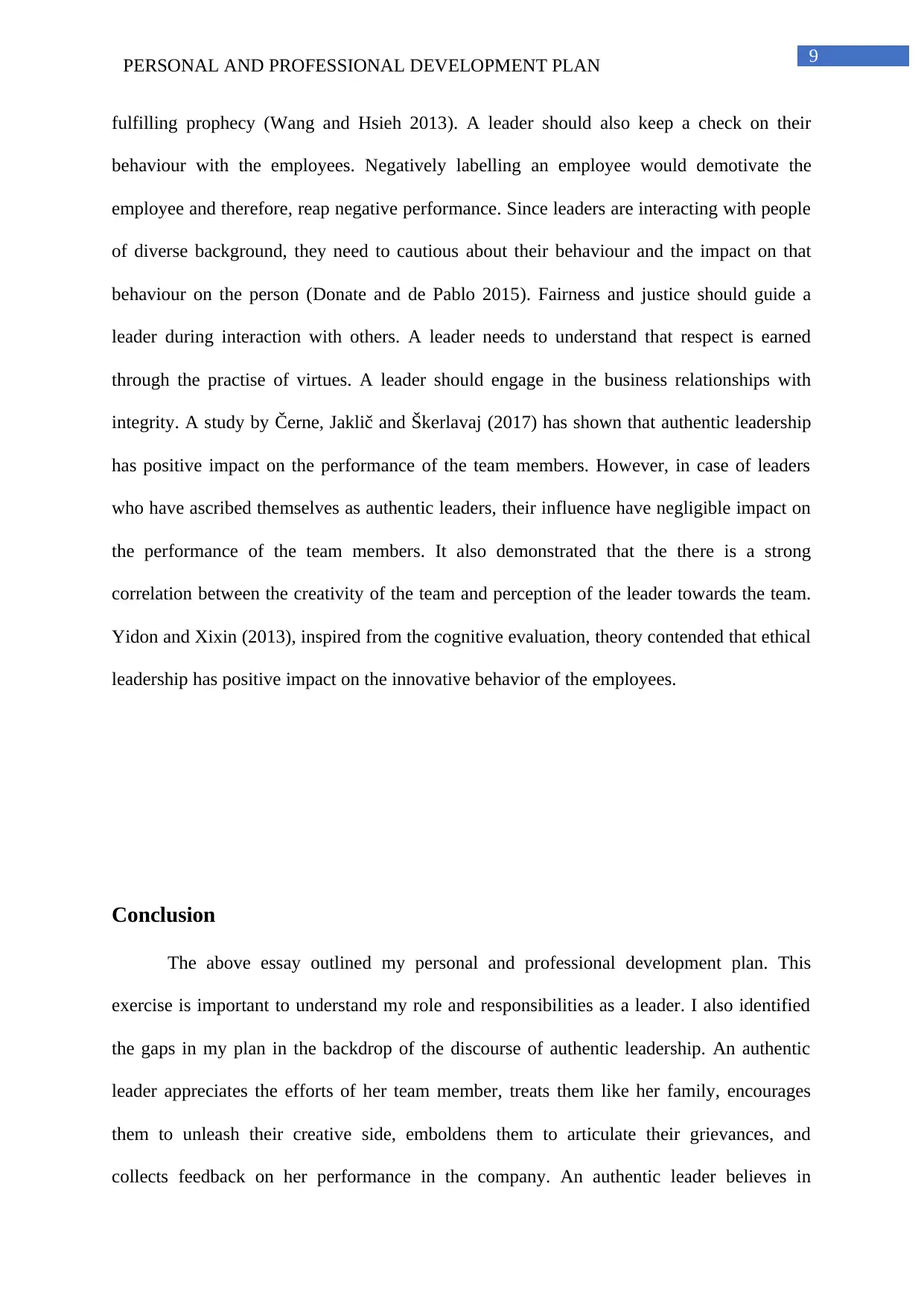
9
PERSONAL AND PROFESSIONAL DEVELOPMENT PLAN
fulfilling prophecy (Wang and Hsieh 2013). A leader should also keep a check on their
behaviour with the employees. Negatively labelling an employee would demotivate the
employee and therefore, reap negative performance. Since leaders are interacting with people
of diverse background, they need to cautious about their behaviour and the impact on that
behaviour on the person (Donate and de Pablo 2015). Fairness and justice should guide a
leader during interaction with others. A leader needs to understand that respect is earned
through the practise of virtues. A leader should engage in the business relationships with
integrity. A study by Černe, Jaklič and Škerlavaj (2017) has shown that authentic leadership
has positive impact on the performance of the team members. However, in case of leaders
who have ascribed themselves as authentic leaders, their influence have negligible impact on
the performance of the team members. It also demonstrated that the there is a strong
correlation between the creativity of the team and perception of the leader towards the team.
Yidon and Xixin (2013), inspired from the cognitive evaluation, theory contended that ethical
leadership has positive impact on the innovative behavior of the employees.
Conclusion
The above essay outlined my personal and professional development plan. This
exercise is important to understand my role and responsibilities as a leader. I also identified
the gaps in my plan in the backdrop of the discourse of authentic leadership. An authentic
leader appreciates the efforts of her team member, treats them like her family, encourages
them to unleash their creative side, emboldens them to articulate their grievances, and
collects feedback on her performance in the company. An authentic leader believes in
PERSONAL AND PROFESSIONAL DEVELOPMENT PLAN
fulfilling prophecy (Wang and Hsieh 2013). A leader should also keep a check on their
behaviour with the employees. Negatively labelling an employee would demotivate the
employee and therefore, reap negative performance. Since leaders are interacting with people
of diverse background, they need to cautious about their behaviour and the impact on that
behaviour on the person (Donate and de Pablo 2015). Fairness and justice should guide a
leader during interaction with others. A leader needs to understand that respect is earned
through the practise of virtues. A leader should engage in the business relationships with
integrity. A study by Černe, Jaklič and Škerlavaj (2017) has shown that authentic leadership
has positive impact on the performance of the team members. However, in case of leaders
who have ascribed themselves as authentic leaders, their influence have negligible impact on
the performance of the team members. It also demonstrated that the there is a strong
correlation between the creativity of the team and perception of the leader towards the team.
Yidon and Xixin (2013), inspired from the cognitive evaluation, theory contended that ethical
leadership has positive impact on the innovative behavior of the employees.
Conclusion
The above essay outlined my personal and professional development plan. This
exercise is important to understand my role and responsibilities as a leader. I also identified
the gaps in my plan in the backdrop of the discourse of authentic leadership. An authentic
leader appreciates the efforts of her team member, treats them like her family, encourages
them to unleash their creative side, emboldens them to articulate their grievances, and
collects feedback on her performance in the company. An authentic leader believes in
Paraphrase This Document
Need a fresh take? Get an instant paraphrase of this document with our AI Paraphraser
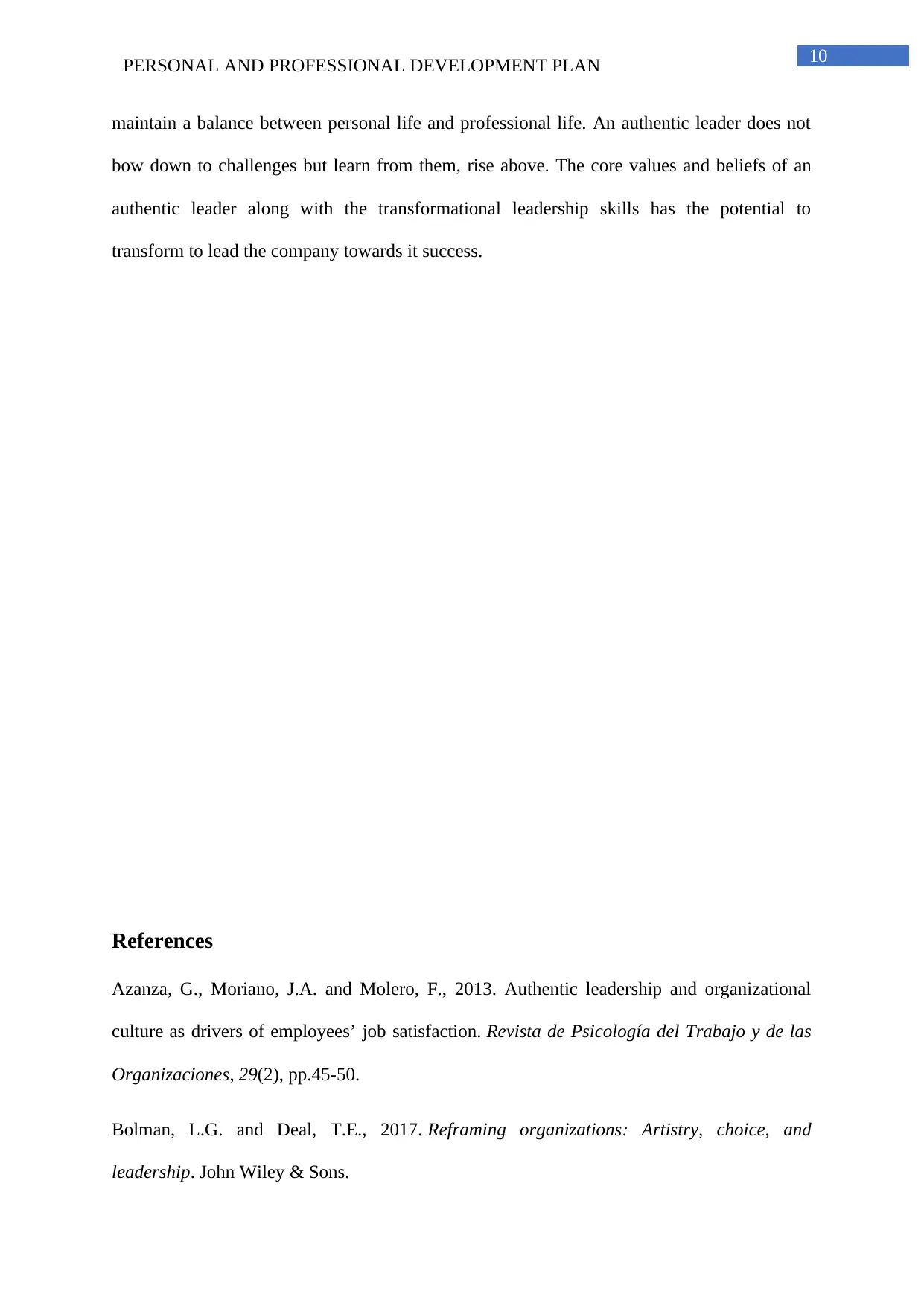
10
PERSONAL AND PROFESSIONAL DEVELOPMENT PLAN
maintain a balance between personal life and professional life. An authentic leader does not
bow down to challenges but learn from them, rise above. The core values and beliefs of an
authentic leader along with the transformational leadership skills has the potential to
transform to lead the company towards it success.
References
Azanza, G., Moriano, J.A. and Molero, F., 2013. Authentic leadership and organizational
culture as drivers of employees’ job satisfaction. Revista de Psicología del Trabajo y de las
Organizaciones, 29(2), pp.45-50.
Bolman, L.G. and Deal, T.E., 2017. Reframing organizations: Artistry, choice, and
leadership. John Wiley & Sons.
PERSONAL AND PROFESSIONAL DEVELOPMENT PLAN
maintain a balance between personal life and professional life. An authentic leader does not
bow down to challenges but learn from them, rise above. The core values and beliefs of an
authentic leader along with the transformational leadership skills has the potential to
transform to lead the company towards it success.
References
Azanza, G., Moriano, J.A. and Molero, F., 2013. Authentic leadership and organizational
culture as drivers of employees’ job satisfaction. Revista de Psicología del Trabajo y de las
Organizaciones, 29(2), pp.45-50.
Bolman, L.G. and Deal, T.E., 2017. Reframing organizations: Artistry, choice, and
leadership. John Wiley & Sons.
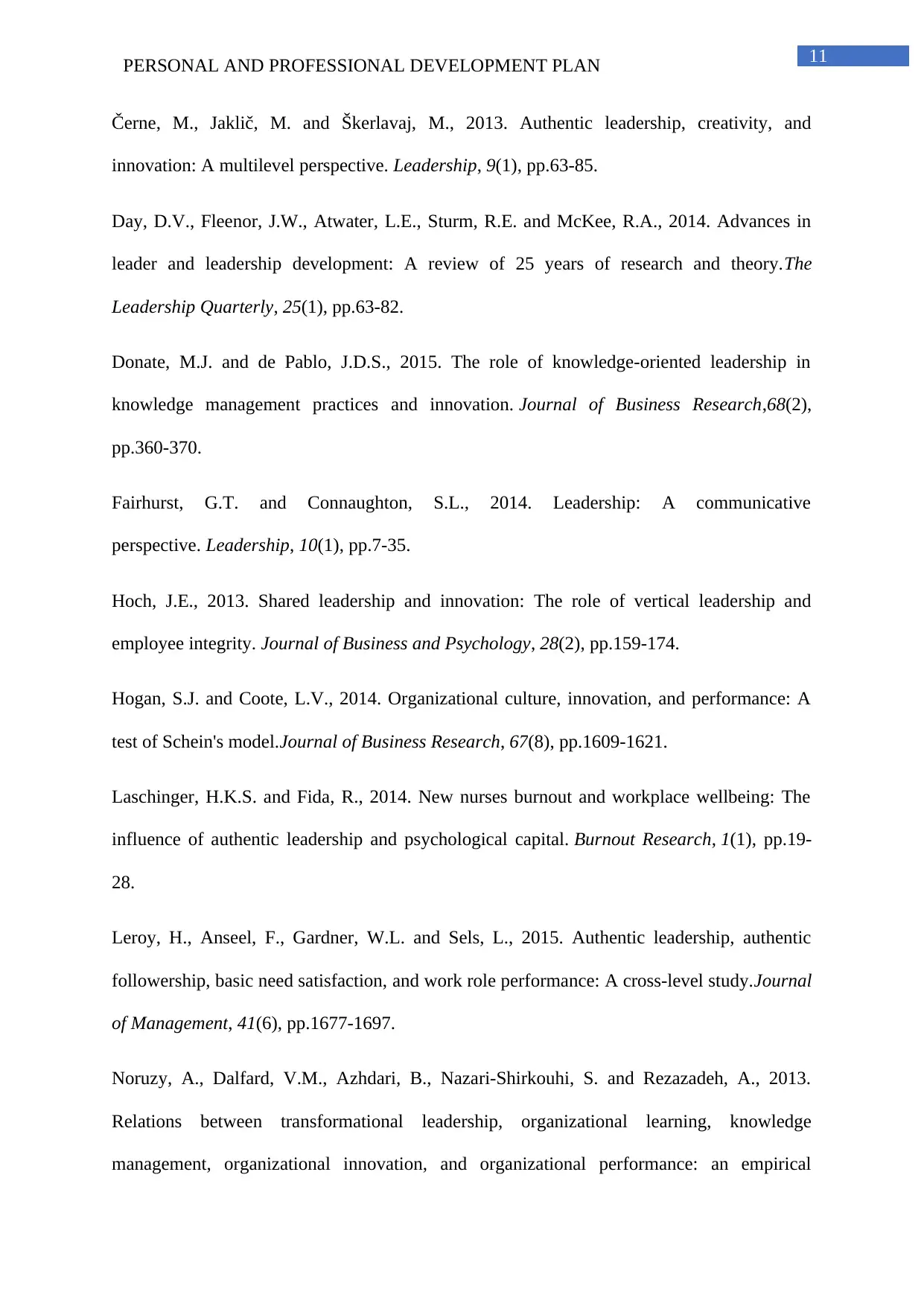
11
PERSONAL AND PROFESSIONAL DEVELOPMENT PLAN
Černe, M., Jaklič, M. and Škerlavaj, M., 2013. Authentic leadership, creativity, and
innovation: A multilevel perspective. Leadership, 9(1), pp.63-85.
Day, D.V., Fleenor, J.W., Atwater, L.E., Sturm, R.E. and McKee, R.A., 2014. Advances in
leader and leadership development: A review of 25 years of research and theory.The
Leadership Quarterly, 25(1), pp.63-82.
Donate, M.J. and de Pablo, J.D.S., 2015. The role of knowledge-oriented leadership in
knowledge management practices and innovation. Journal of Business Research,68(2),
pp.360-370.
Fairhurst, G.T. and Connaughton, S.L., 2014. Leadership: A communicative
perspective. Leadership, 10(1), pp.7-35.
Hoch, J.E., 2013. Shared leadership and innovation: The role of vertical leadership and
employee integrity. Journal of Business and Psychology, 28(2), pp.159-174.
Hogan, S.J. and Coote, L.V., 2014. Organizational culture, innovation, and performance: A
test of Schein's model.Journal of Business Research, 67(8), pp.1609-1621.
Laschinger, H.K.S. and Fida, R., 2014. New nurses burnout and workplace wellbeing: The
influence of authentic leadership and psychological capital. Burnout Research, 1(1), pp.19-
28.
Leroy, H., Anseel, F., Gardner, W.L. and Sels, L., 2015. Authentic leadership, authentic
followership, basic need satisfaction, and work role performance: A cross-level study.Journal
of Management, 41(6), pp.1677-1697.
Noruzy, A., Dalfard, V.M., Azhdari, B., Nazari-Shirkouhi, S. and Rezazadeh, A., 2013.
Relations between transformational leadership, organizational learning, knowledge
management, organizational innovation, and organizational performance: an empirical
PERSONAL AND PROFESSIONAL DEVELOPMENT PLAN
Černe, M., Jaklič, M. and Škerlavaj, M., 2013. Authentic leadership, creativity, and
innovation: A multilevel perspective. Leadership, 9(1), pp.63-85.
Day, D.V., Fleenor, J.W., Atwater, L.E., Sturm, R.E. and McKee, R.A., 2014. Advances in
leader and leadership development: A review of 25 years of research and theory.The
Leadership Quarterly, 25(1), pp.63-82.
Donate, M.J. and de Pablo, J.D.S., 2015. The role of knowledge-oriented leadership in
knowledge management practices and innovation. Journal of Business Research,68(2),
pp.360-370.
Fairhurst, G.T. and Connaughton, S.L., 2014. Leadership: A communicative
perspective. Leadership, 10(1), pp.7-35.
Hoch, J.E., 2013. Shared leadership and innovation: The role of vertical leadership and
employee integrity. Journal of Business and Psychology, 28(2), pp.159-174.
Hogan, S.J. and Coote, L.V., 2014. Organizational culture, innovation, and performance: A
test of Schein's model.Journal of Business Research, 67(8), pp.1609-1621.
Laschinger, H.K.S. and Fida, R., 2014. New nurses burnout and workplace wellbeing: The
influence of authentic leadership and psychological capital. Burnout Research, 1(1), pp.19-
28.
Leroy, H., Anseel, F., Gardner, W.L. and Sels, L., 2015. Authentic leadership, authentic
followership, basic need satisfaction, and work role performance: A cross-level study.Journal
of Management, 41(6), pp.1677-1697.
Noruzy, A., Dalfard, V.M., Azhdari, B., Nazari-Shirkouhi, S. and Rezazadeh, A., 2013.
Relations between transformational leadership, organizational learning, knowledge
management, organizational innovation, and organizational performance: an empirical
⊘ This is a preview!⊘
Do you want full access?
Subscribe today to unlock all pages.

Trusted by 1+ million students worldwide
1 out of 13
Related Documents
Your All-in-One AI-Powered Toolkit for Academic Success.
+13062052269
info@desklib.com
Available 24*7 on WhatsApp / Email
![[object Object]](/_next/static/media/star-bottom.7253800d.svg)
Unlock your academic potential
Copyright © 2020–2025 A2Z Services. All Rights Reserved. Developed and managed by ZUCOL.




